
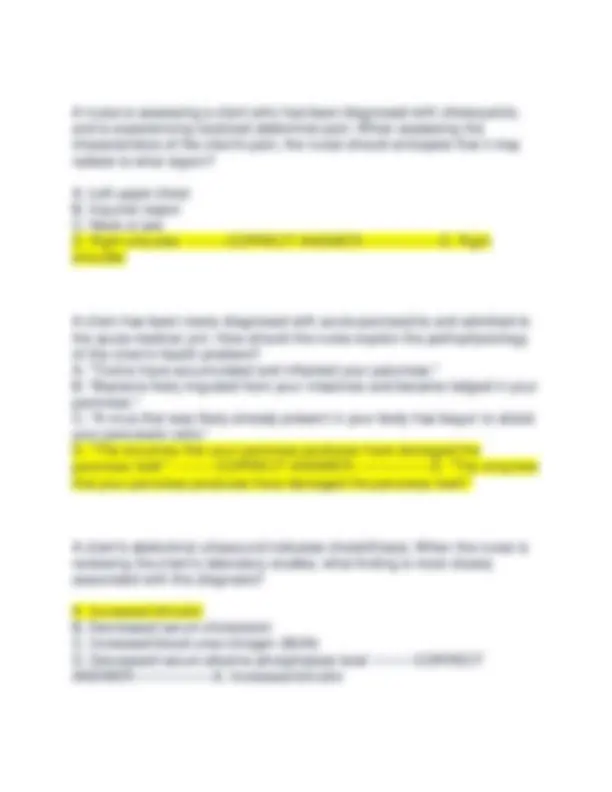
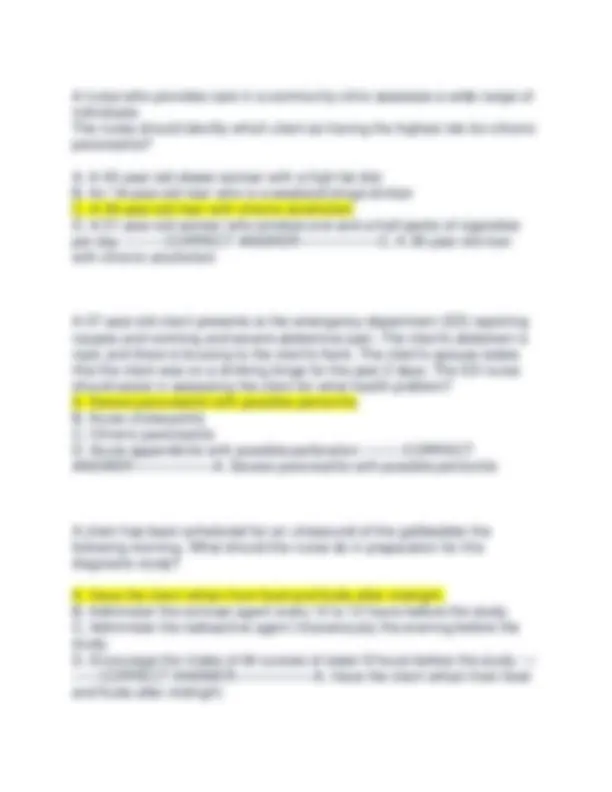
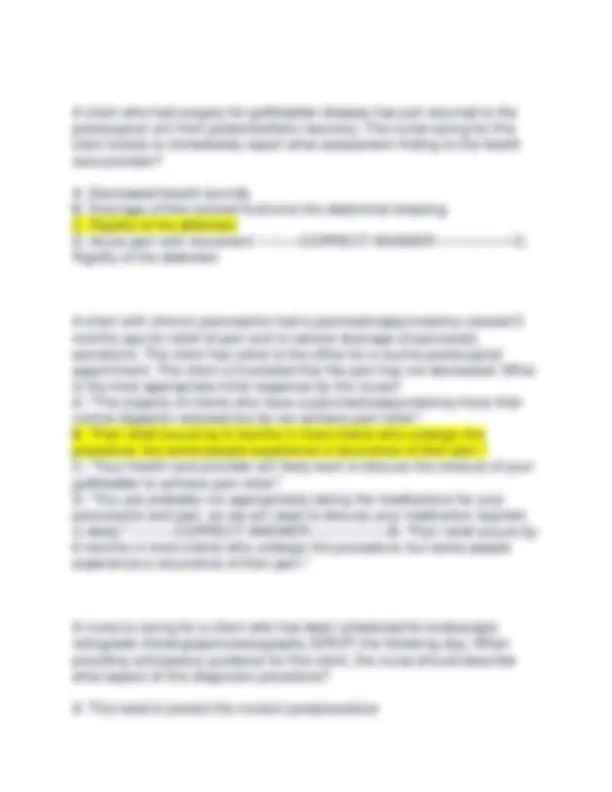
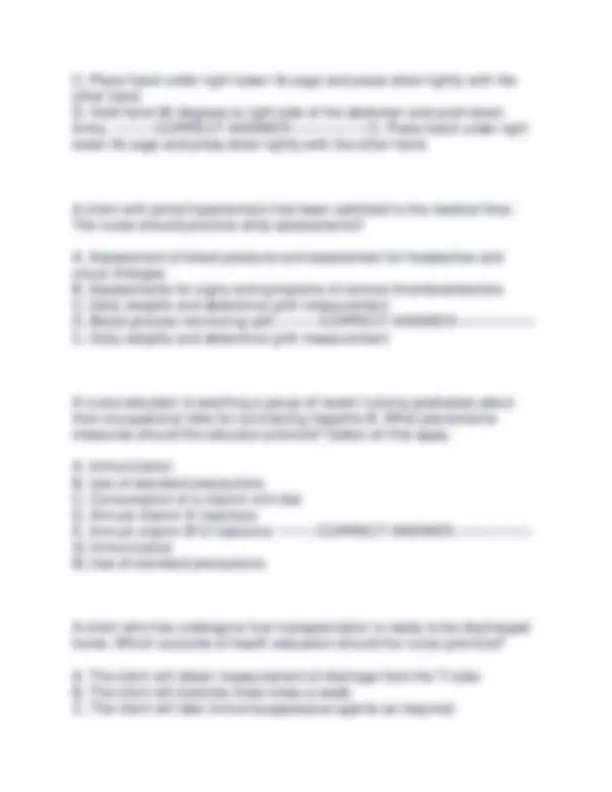
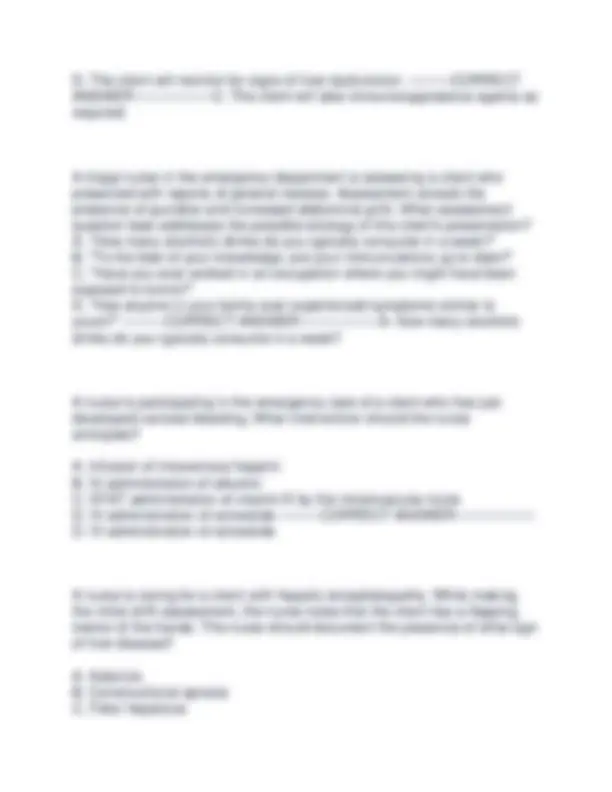
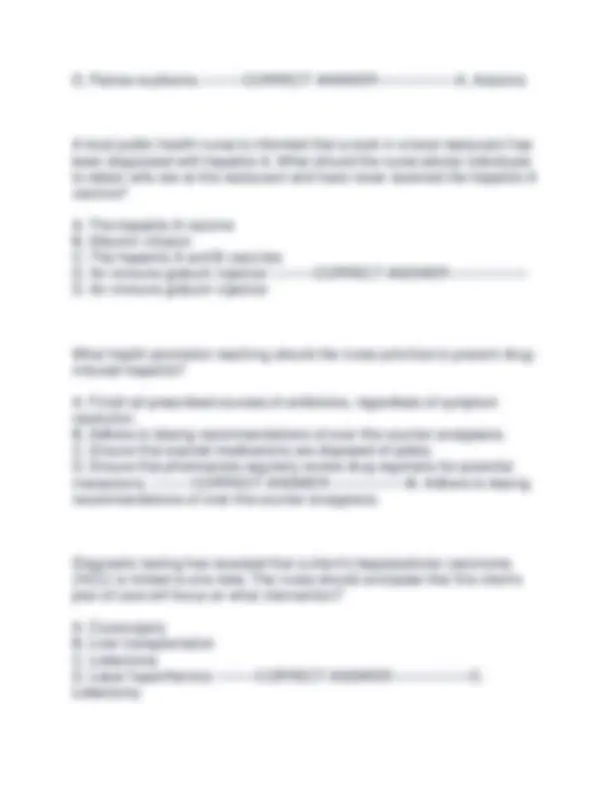
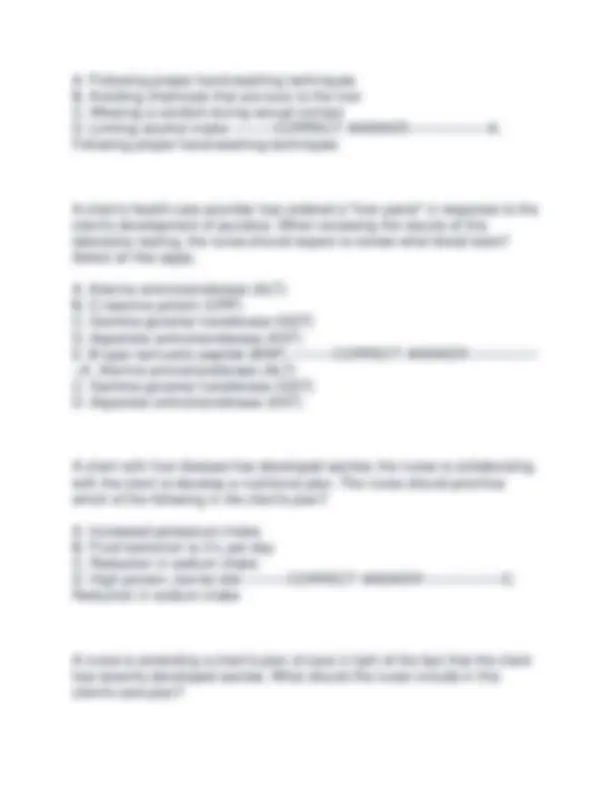
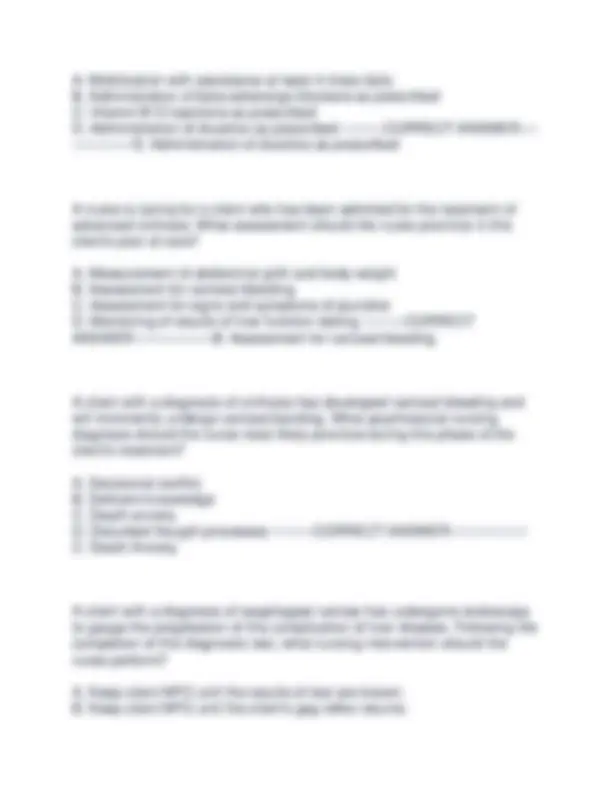
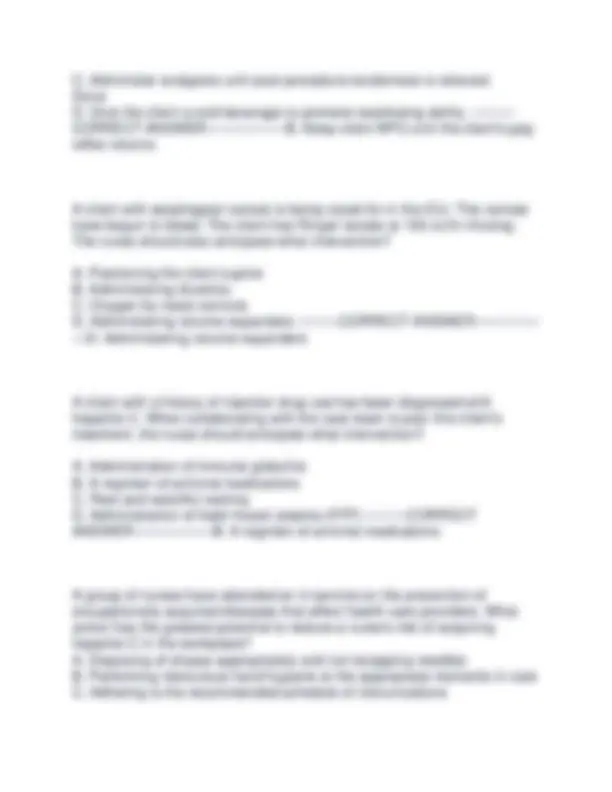
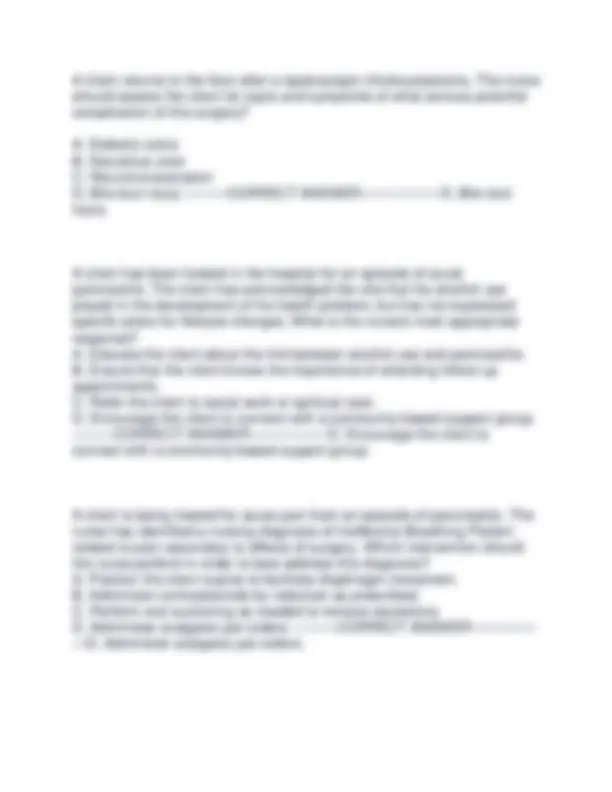
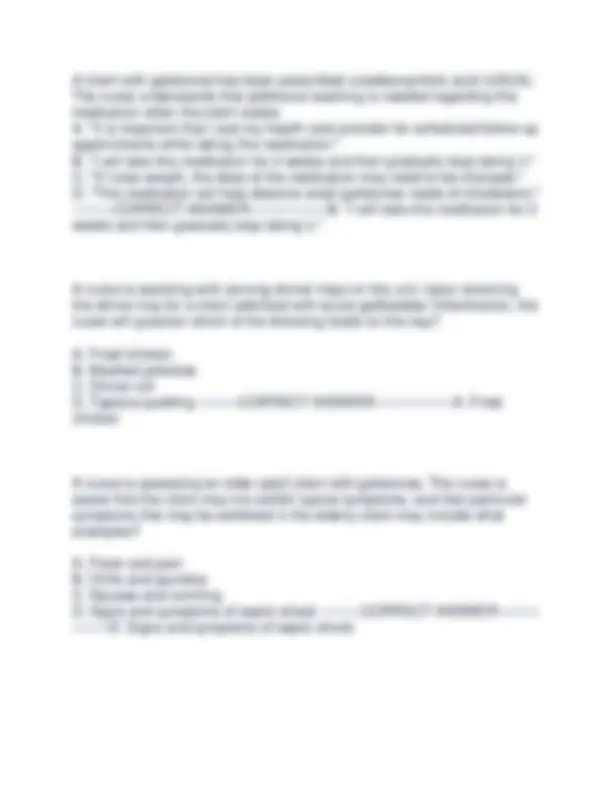
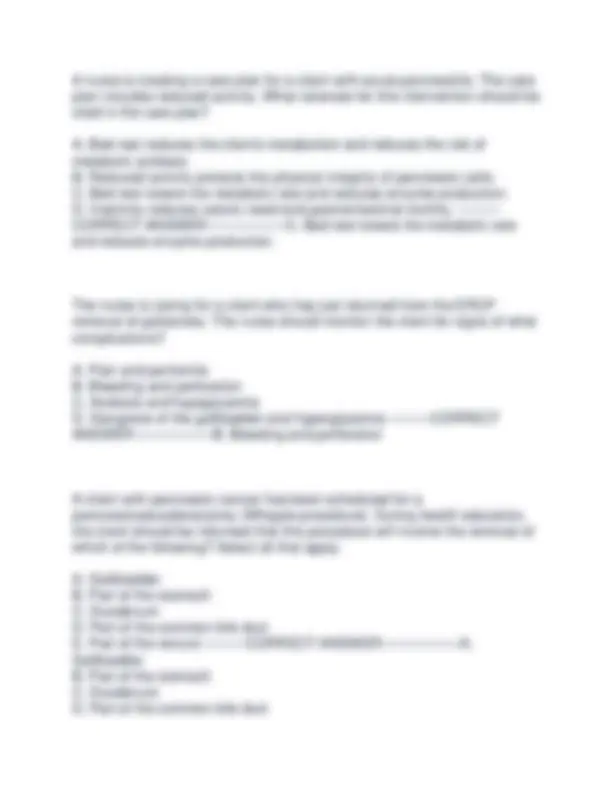
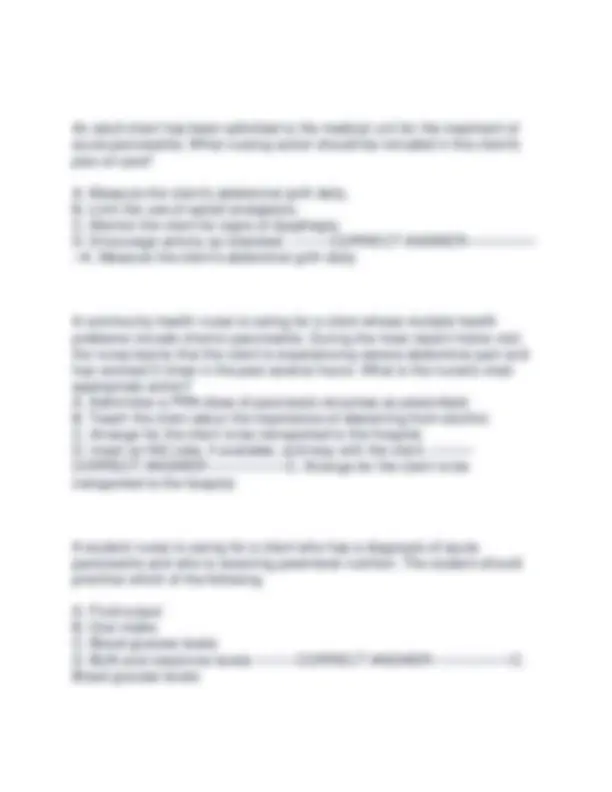
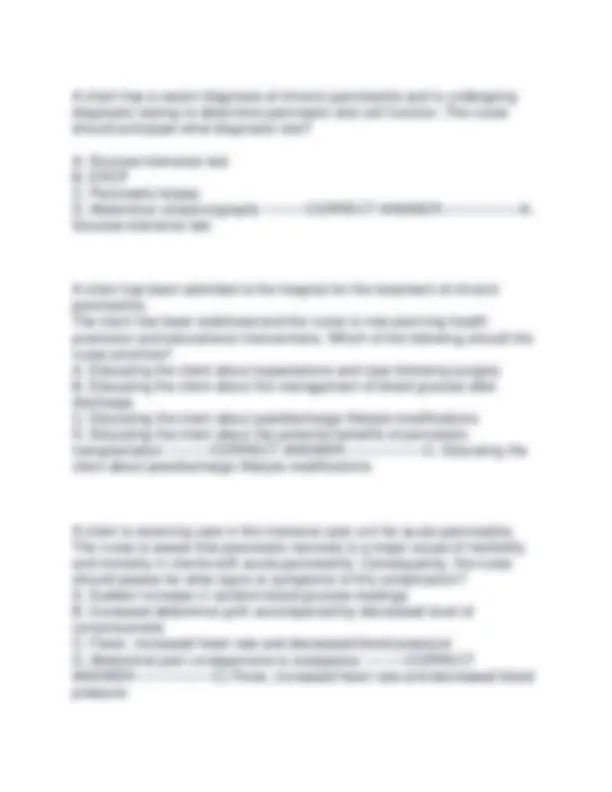
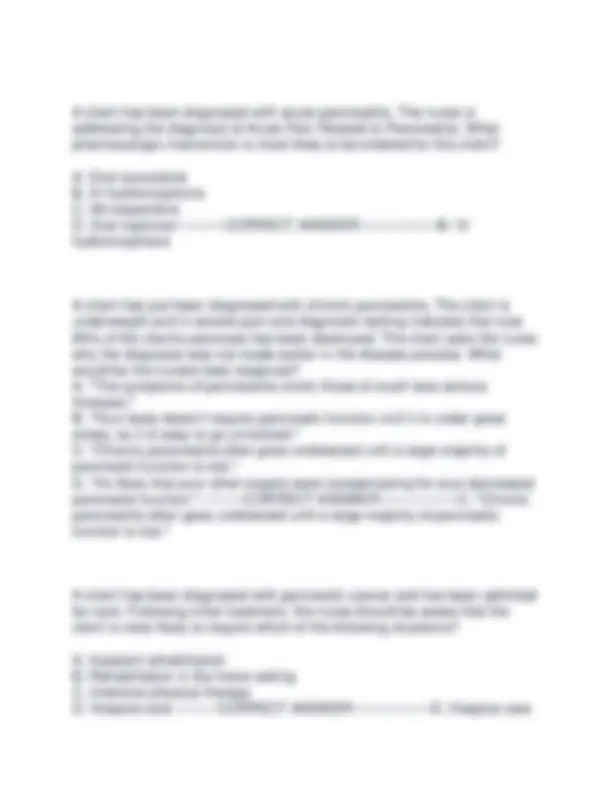
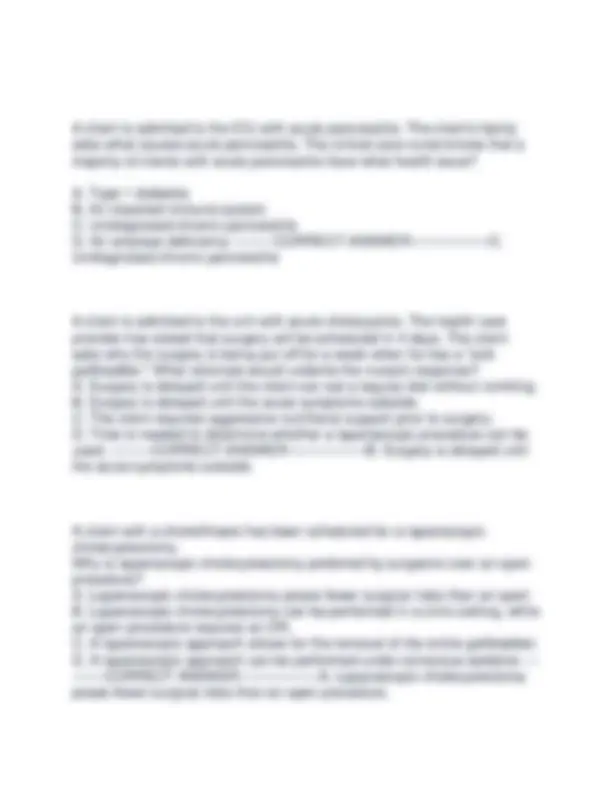
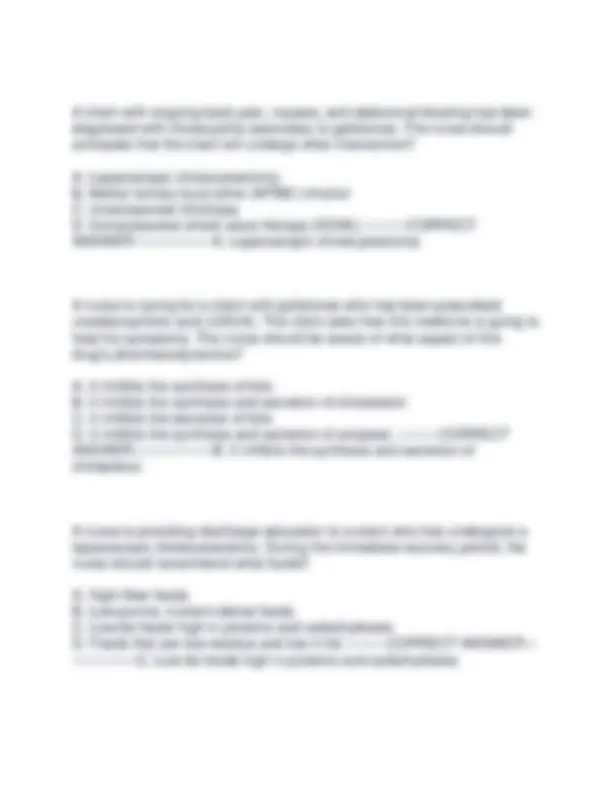
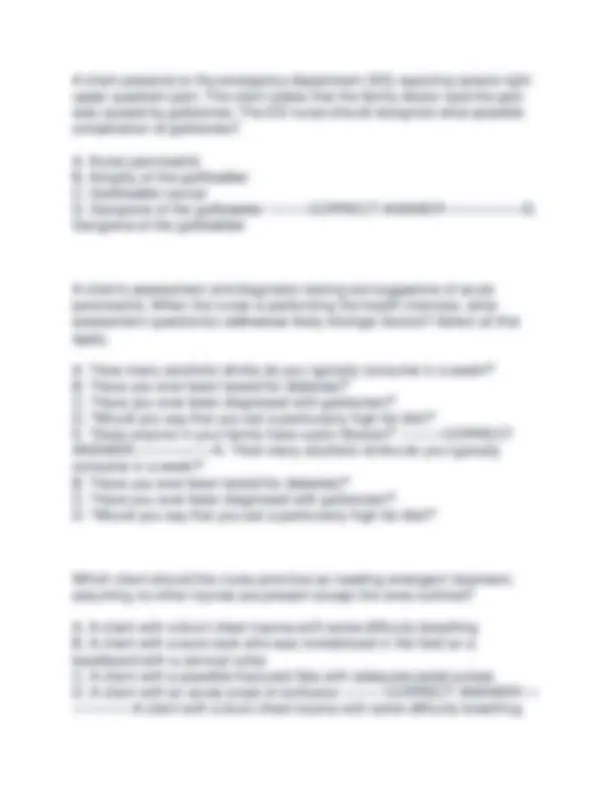
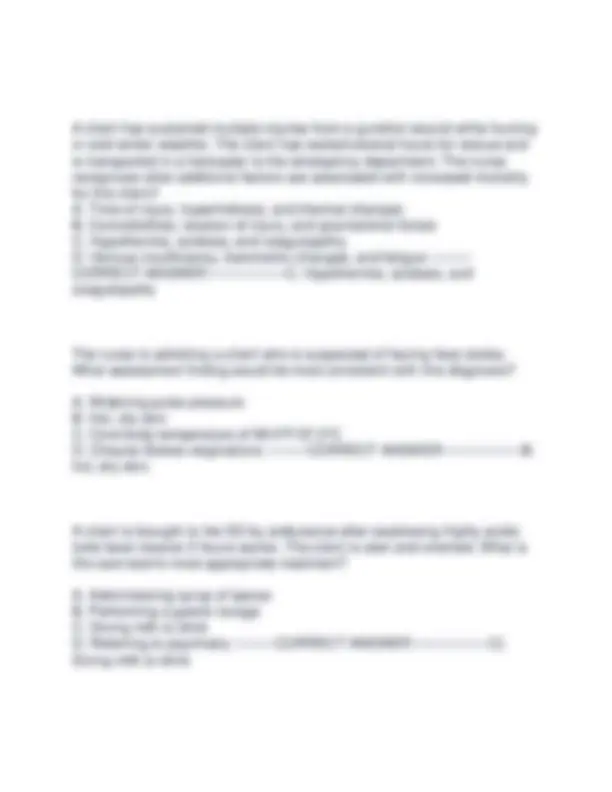
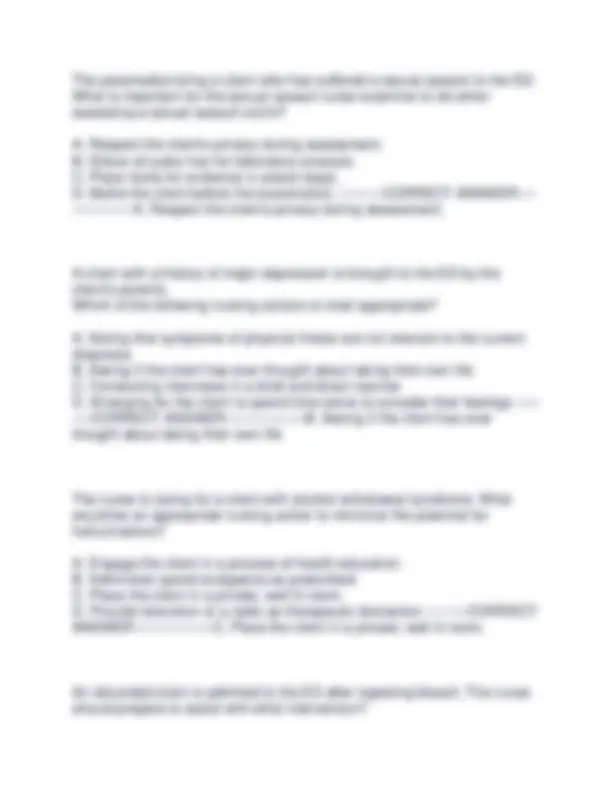
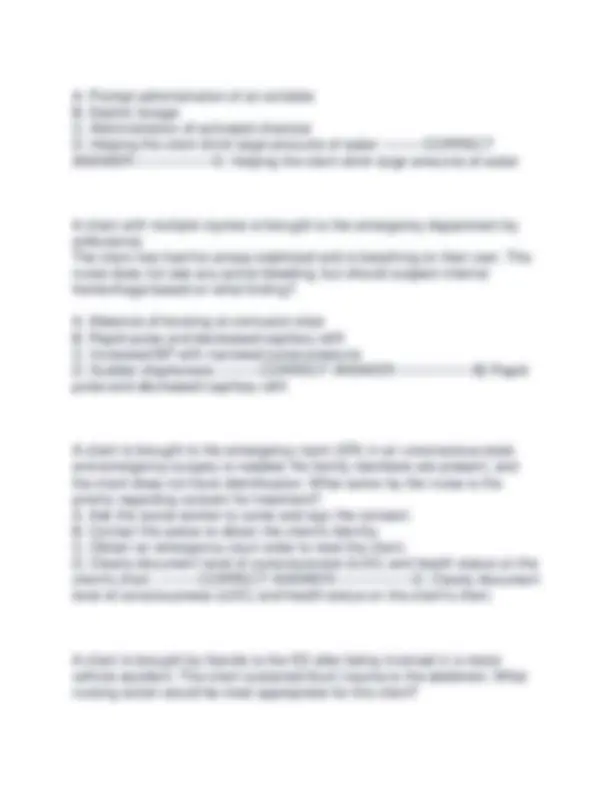
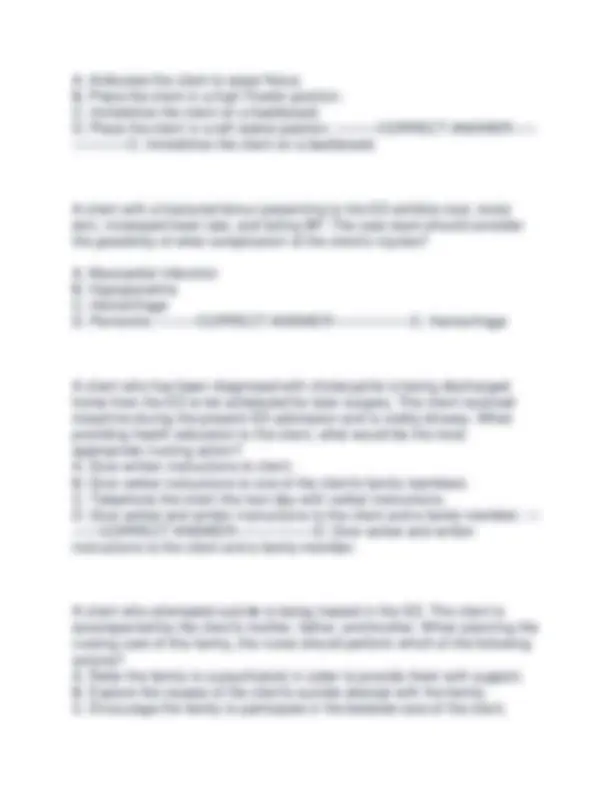
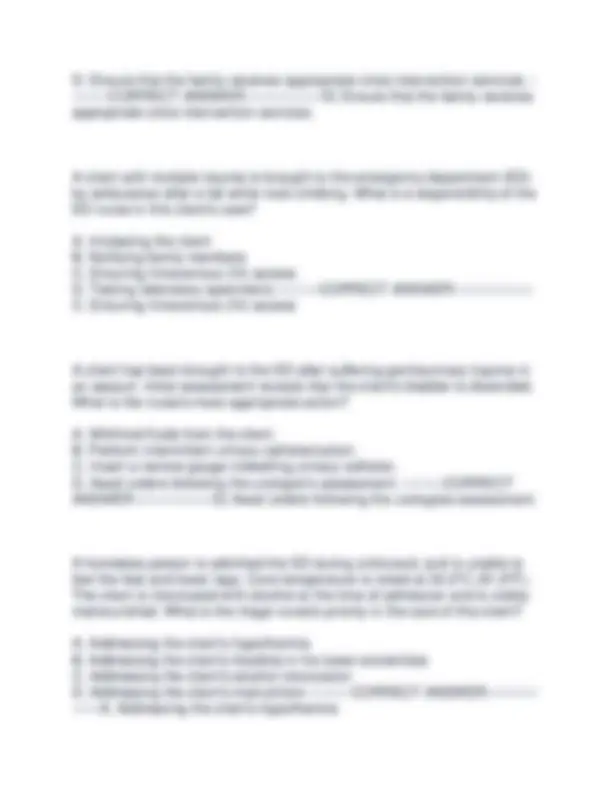
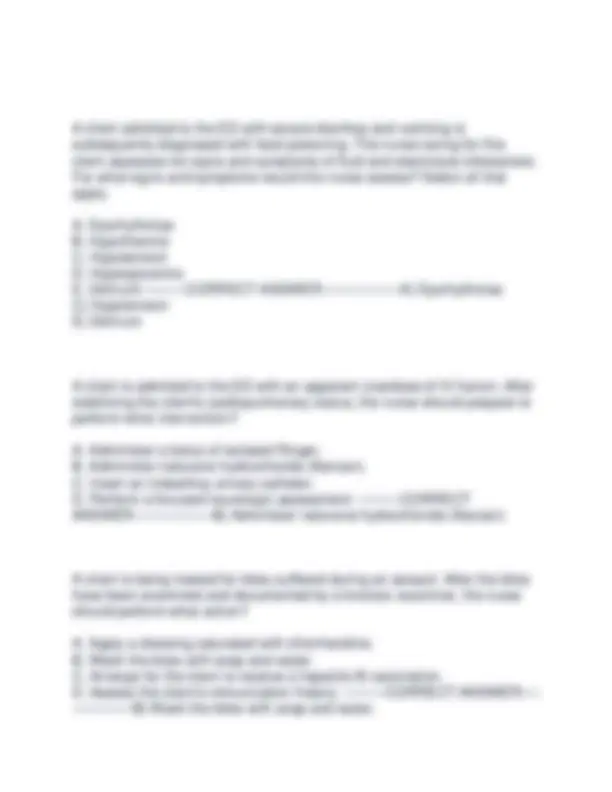
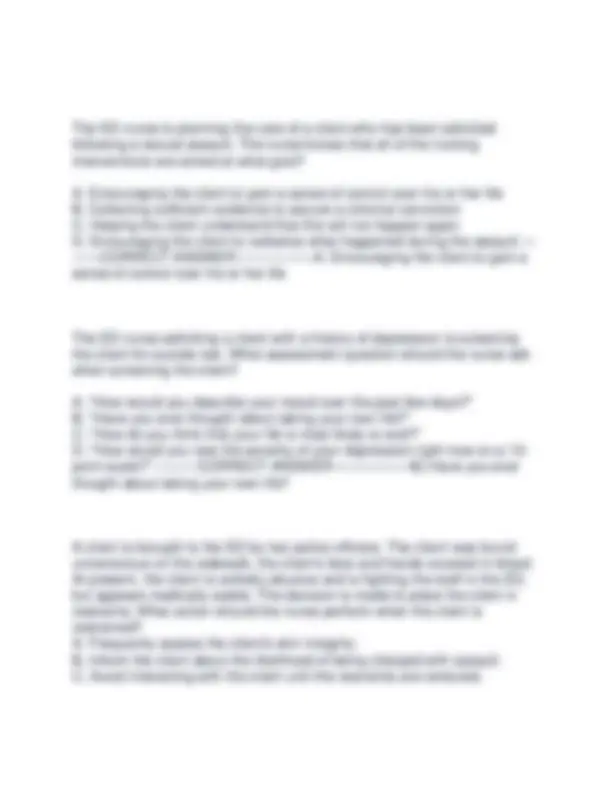
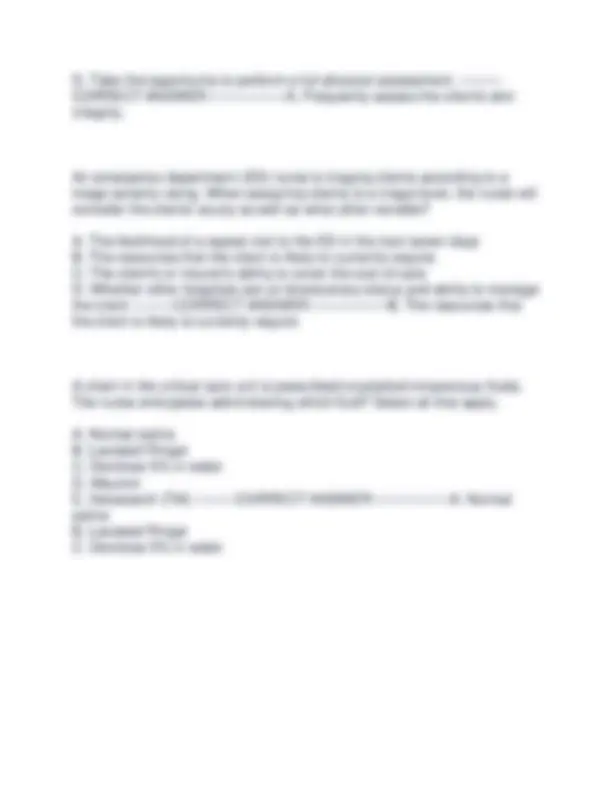


Study with the several resources on Docsity

Earn points by helping other students or get them with a premium plan


Prepare for your exams
Study with the several resources on Docsity

Earn points to download
Earn points by helping other students or get them with a premium plan
Community
Ask the community for help and clear up your study doubts
Discover the best universities in your country according to Docsity users
Free resources
Download our free guides on studying techniques, anxiety management strategies, and thesis advice from Docsity tutors
NSG 4100 EXAM 1 NEWEST EXAM 2025 | ALL QUESTIONS AND CORRECT ANSWERS | ALREADY GRADED A+ | VERIFIED ANSWERS | LATEST EXAM (JUST RELEASED)
Typology: Exams
1 / 34

This page cannot be seen from the preview
Don't miss anything!



























A nurse has entered the room of a client with cirrhosis and found the client on the floor. The client reports falling when transferring to the commode. The client's vital signs are within reference ranges and the nurse observes no apparent injuries. What is the nurse's most appropriate action? A. Remove the client's commode and supply a bedpan. B. Complete an incident report and submit it to the unit supervisor. C. Have the client assessed by the primary provider due to the risk of internal bleeding. D. Perform a focused abdominal assessment in order to rule out injury. ----- ----CORRECT ANSWER-----------------C. Have the client assessed by the primary provider due to the risk of internal bleeding. A client with liver cancer is being discharged home with a hepatic artery catheter in place. The nurse should be aware that this catheter will facilitate which of the following? A. Continuous monitoring for portal hypertension B. Administration of immunosuppressive drugs during the first weeks after transplantation C. Real-time monitoring of vascular changes in the hepatic system D. Delivery of a continuous chemotherapeutic dose ---------CORRECT ANSWER-----------------D. Delivery of a continuous chemotherapeutic dose A nurse on a solid organ transplant unit is planning the care of a client who will soon be admitted upon immediate recovery following liver transplantation. What aspect of nursing care is the nurse's priority? A. Implementation of infection-control measures
B. Close monitoring of skin integrity and color C. Frequent assessment of the client's psychosocial status D. Administration of antiretroviral medications ---------CORRECT ANSWER- ----------------A. Implementation of infection-control measures A 55-year-old female client with hepatocellular carcinoma (HCC) is undergoing radiofrequency ablation. The nurse should recognize what goal of this treatment? A. Destruction of the client's liver tumor B. Restoration of portal vein patency Done C. Destruction of a liver abscess D. Reversal of metastasis ---------CORRECT ANSWER-----------------A. Destruction of the client's liver tumor A nurse is caring for a client with severe hemolytic jaundice. Laboratory tests show free bilirubin to be 24 mg/dL (408 mmol/L). For what complication is this client at risk? A. Chronic jaundice B. Pigment stones in portal circulation C. Central nervous system damage D. Hepatomegaly ---------CORRECT ANSWER-----------------C. Central nervous system damage The nurse's review of a client's most recent laboratory results indicates a bilirubin level of 3.0 mg/dL (51 mmol/L). The nurse assesses the client for: A. jaundice. B. bleeding. C. malnutrition. D. hypokalemia. ---------CORRECT ANSWER-----------------A. jaundice.
A nurse who provides care in a community clinic assesses a wide range of individuals. The nurse should identify which client as having the highest risk for chronic pancreatitis? A. A 45-year-old obese woman with a high-fat diet B. An 18-year-old man who is a weekend binge drinker C. A 39-year-old man with chronic alcoholism D. A 51-year-old woman who smokes one-and-a-half packs of cigarettes per day ---------CORRECT ANSWER-----------------C. A 39-year-old man with chronic alcoholism A 37-year-old client presents at the emergency department (ED) reporting nausea and vomiting and severe abdominal pain. The client's abdomen is rigid, and there is bruising to the client's flank. The client's spouse states that the client was on a drinking binge for the past 2 days. The ED nurse should assist in assessing the client for what health problem? A. Severe pancreatitis with possible peritonitis B. Acute cholecystitis C. Chronic pancreatitis D. Acute appendicitis with possible perforation ---------CORRECT ANSWER-----------------A. Severe pancreatitis with possible peritonitis A client has been scheduled for an ultrasound of the gallbladder the following morning. What should the nurse do in preparation for this diagnostic study? A. Have the client refrain from food and fluids after midnight. B. Administer the contrast agent orally 10 to 12 hours before the study. C. Administer the radioactive agent intravenously the evening before the study. D. Encourage the intake of 64 ounces of water 8 hours before the study. --- ------CORRECT ANSWER-----------------A. Have the client refrain from food and fluids after midnight.
A client who had surgery for gallbladder disease has just returned to the postsurgical unit from postanesthetic recovery. The nurse caring for this client knows to immediately report what assessment finding to the health care provider? A. Decreased breath sounds B. Drainage of bile-colored fluid onto the abdominal dressing C. Rigidity of the abdomen D. Acute pain with movement ---------CORRECT ANSWER-----------------C. Rigidity of the abdomen A client with chronic pancreatitis had a pancreaticojejunostomy created 3 months ago for relief of pain and to restore drainage of pancreatic secretions. The client has come to the office for a routine postsurgical appointment. The client is frustrated that the pain has not decreased. What is the most appropriate initial response by the nurse? A. "The majority of clients who have a pancreaticojejunostomy have their normal digestion restored but do not achieve pain relief." B. "Pain relief occurs by 6 months in most clients who undergo this procedure, but some people experience a recurrence of their pain." C. "Your health care provider will likely want to discuss the removal of your gallbladder to achieve pain relief." D. "You are probably not appropriately taking the medications for your pancreatitis and pain, so we will need to discuss your medication regimen in detail." ---------CORRECT ANSWER-----------------B. "Pain relief occurs by 6 months in most clients who undergo this procedure, but some people experience a recurrence of their pain." A nurse is caring for a client who has been scheduled for endoscopic retrograde cholangiopancreatography (ERCP) the following day. When providing anticipatory guidance for this client, the nurse should describe what aspect of this diagnostic procedure? A. The need to protect the incision postprocedure
B. Hemorrhage and hypercalcemia C. Weight loss and hypoglycemia D. Malabsorption and hyperglycemia ---------CORRECT ANSWER------------ -----D. Malabsorption and hyperglycemia A client has had a laparoscopic cholecystectomy. The client is now reporting right shoulder pain. What should the nurse suggest to relieve the pain? A. Aspirin every 4 to 6 hours as prescribed B. Application of heat 15 to 20 minutes each hour C. Application of an ice pack for no more than 15 minutes D. Application of liniment rub to affected area ---------CORRECT ANSWER- ----------------B. Application of heat 15 to 20 minutes each hour A nurse is caring for a client with liver failure and is performing an assessment of the client's increased risk of bleeding. The nurse recognizes that this risk is related to the client's inability to synthesize prothrombin in the liver. What factor most likely contributes to this loss of function? A. Alterations in glucose metabolism B. Retention of bile salts C. Inadequate production of albumin by hepatocytes D. Inability of the liver to use vitamin K ---------CORRECT ANSWER---------- -------D. Inability of the liver to use vitamin K. A nurse is performing an admission assessment of a client with a diagnosis of cirrhosis. What technique should the nurse use to palpate the client's liver? A. Place hand under the right lower abdominal quadrant and press down lightly with the other hand. B. Place the left hand over the abdomen and behind the left side at the 11th rib.
C. Place hand under right lower rib cage and press down lightly with the other hand. D. Hold hand 90 degrees to right side of the abdomen and push down firmly. ---------CORRECT ANSWER-----------------C. Place hand under right lower rib cage and press down lightly with the other hand. A client with portal hypertension has been admitted to the medical floor. The nurse should prioritize what assessments? A. Assessment of blood pressure and assessment for headaches and visual changes B. Assessments for signs and symptoms of venous thromboembolism C. Daily weights and abdominal girth measurement D. Blood glucose monitoring q4h ---------CORRECT ANSWER----------------- C. Daily weights and abdominal girth measurement A nurse educator is teaching a group of recent nursing graduates about their occupational risks for contracting hepatitis B. What preventative measures should the educator promote? Select all that apply. A. Immunization B. Use of standard precautions C. Consumption of a vitamin-rich diet D. Annual vitamin K injections E. Annual vitamin B12 injections ---------CORRECT ANSWER----------------- A) Immunization B) Use of standard precautions A client who has undergone liver transplantation is ready to be discharged home. Which outcome of health education should the nurse prioritize? A. The client will obtain measurement of drainage from the T-tube. B. The client will exercise three times a week. C. The client will take immunosuppressive agents as required.
D. Palmar erythema ---------CORRECT ANSWER-----------------A. Asterixis A local public health nurse is informed that a cook in a local restaurant has been diagnosed with hepatitis A. What should the nurse advise individuals to obtain who ate at this restaurant and have never received the hepatitis A vaccine? A. The hepatitis A vaccine B. Albumin infusion C. The hepatitis A and B vaccines D. An immune globulin injection ---------CORRECT ANSWER----------------- D. An immune globulin injection What health promotion teaching should the nurse prioritize to prevent drug- induced hepatitis? A. Finish all prescribed courses of antibiotics, regardless of symptom resolution. B. Adhere to dosing recommendations of over-the-counter analgesics. C. Ensure that expired medications are disposed of safely. D. Ensure that pharmacists regularly review drug regimens for potential interactions. ---------CORRECT ANSWER-----------------B. Adhere to dosing recommendations of over-the-counter analgesics. Diagnostic testing has revealed that a client's hepatocellular carcinoma (HCC) is limited to one lobe. The nurse should anticipate that this client's plan of care will focus on what intervention? A. Cryosurgery B. Liver transplantation C. Lobectomy D. Laser hyperthermia ---------CORRECT ANSWER-----------------C. Lobectomy
A client has been diagnosed with advanced stage breast cancer and will soon begin aggressive treatment. What assessment findings would most strongly suggest that the client may have developed liver metastases? A. Persistent fever and cognitive changes B. Abdominal pain and hepatomegaly C. Peripheral edema unresponsive to diuresis D. Spontaneous bleeding and jaundice ---------CORRECT ANSWER---------- -------B. Abdominal pain and hepatomegaly A client is being discharged after a liver transplant and the nurse is performing discharge education. When planning this client's continuing care, the nurse should prioritize what risk diagnosis? A. Risk for infection related to immunosuppressant use B. Risk for injury related to decreased hemostasis C. Risk for unstable blood glucose related to impaired gluconeogenesis D. Risk for contamination related to accumulation of ammonia --------- CORRECT ANSWER-----------------A. Risk for Infection Related to Immunosuppressant Use A nurse is caring for a client with hepatic encephalopathy. The nurse's assessment reveals that the client exhibits episodes of confusion, is difficult to arouse from sleep and has rigid extremities. Based on these clinical findings, the nurse should document what stage of hepatic encephalopathy? A. Stage 1 B. Stage 2 C. Stage 3 D. Stage 4 ---------CORRECT ANSWER-----------------C. Stage 3
A. Following proper hand-washing techniques B. Avoiding chemicals that are toxic to the liver C. Wearing a condom during sexual contact D. Limiting alcohol intake ---------CORRECT ANSWER-----------------A. Following proper hand-washing techniques A client's health care provider has ordered a "liver panel" in response to the client's development of jaundice. When reviewing the results of this laboratory testing, the nurse should expect to review what blood tests? Select all that apply. A. Alanine aminotransferase (ALT) B. C-reactive protein (CRP) C. Gamma-glutamyl transferase (GGT) D. Aspartate aminotransferase (AST) E. B-type natriuretic peptide (BNP) ---------CORRECT ANSWER--------------- --A. Alanine aminotransferase (ALT) C. Gamma-glutamyl transferase (GGT) D. Aspartate aminotransferase (AST) A client with liver disease has developed ascites; the nurse is collaborating with the client to develop a nutritional plan. The nurse should prioritize which of the following in the client's plan? A. Increased potassium intake B. Fluid restriction to 2 L per day C. Reduction in sodium intake D. High-protein, low-fat diet ---------CORRECT ANSWER-----------------C. Reduction in sodium intake A nurse is amending a client's plan of care in light of the fact that the client has recently developed ascites. What should the nurse include in this client's care plan?
A. Mobilization with assistance at least 4 times daily B. Administration of beta-adrenergic blockers as prescribed C. Vitamin B12 injections as prescribed D. Administration of diuretics as prescribed ---------CORRECT ANSWER---- -------------D. Administration of diuretics as prescribed A nurse is caring for a client who has been admitted for the treatment of advanced cirrhosis. What assessment should the nurse prioritize in this client's plan of care? A. Measurement of abdominal girth and body weight B. Assessment for variceal bleeding C. Assessment for signs and symptoms of jaundice D. Monitoring of results of liver function testing ---------CORRECT ANSWER-----------------B. Assessment for variceal bleeding A client with a diagnosis of cirrhosis has developed variceal bleeding and will imminently undergo variceal banding. What psychosocial nursing diagnosis should the nurse most likely prioritize during this phase of the client's treatment? A. Decisional conflict B. Deficient knowledge C. Death anxiety D. Disturbed thought processes ---------CORRECT ANSWER----------------- C. Death Anxiety A client with a diagnosis of esophageal varices has undergone endoscopy to gauge the progression of this complication of liver disease. Following the completion of this diagnostic test, what nursing intervention should the nurse perform? A. Keep client NPO until the results of test are known. B. Keep client NPO until the client's gag reflex returns.
D. Wearing an N95 mask when providing care for clients on airborne precautions ---------CORRECT ANSWER-----------------A. Disposing of sharps appropriately and not recapping needles A client has been admitted to the critical care unit with a diagnosis of toxic hepatitis. When planning the client's care, the nurse should be aware of what potential clinical course of this health problem? Place the following events in the correct sequence.
A client with end-stage liver disease has developed hypervolemia. What nursing interventions would be most appropriate when addressing the client's fluid volume excess? Select all that apply. A. Administering diuretics B. Administering calcium channel blockers C. Implementing fluid restrictions D. Implementing a 1500 kcal/day restriction E. Enhancing client positioning ---------CORRECT ANSWER-----------------A. Administering diuretics C. Implementing fluid restrictions E. Enhancing client positioning A client with liver cancer is being discharged home with a biliary drainage system in place. The nurse should teach the client's family how to safely perform which of the following actions? A. Aspirating bile from the catheter using a syringe B. Removing the catheter when output is ] 15 mL in 24 hours C. Instilling antibiotics into the catheter D. Assessing the patency of the drainage catheter ---------CORRECT ANSWER-----------------D) Assessing the patency of the drainage catheter A client with cirrhosis has experienced a progressive decline in his health; and liver transplantation is being considered by the interdisciplinary team. How will the client's prioritization for receiving a donor liver be determined? A. By considering the client's age and prognosis B. By objectively determining the client's medical need C. By objectively assessing the client's willingness to adhere to post- transplantation care D. By systematically ruling out alternative treatment options --------- CORRECT ANSWER-----------------B. By objectively determining the client's medical need
A client with gallstones has been prescribed ursodeoxycholic acid (UDCA). The nurse understands that additional teaching is needed regarding this medication when the client states: A. "It is important that I see my health care provider for scheduled follow-up appointments while taking this medication." B. "I will take this medication for 2 weeks and then gradually stop taking it." C. "If I lose weight, the dose of the medication may need to be changed." D. "This medication will help dissolve small gallstones made of cholesterol." ---------CORRECT ANSWER-----------------B. "I will take this medication for 2 weeks and then gradually stop taking it." A nurse is assisting with serving dinner trays on the unit. Upon receiving the dinner tray for a client admitted with acute gallbladder inflammation, the nurse will question which of the following foods on the tray? A. Fried chicken B. Mashed potatoes C. Dinner roll D. Tapioca pudding ---------CORRECT ANSWER-----------------A. Fried chicken A nurse is assessing an older adult client with gallstones. The nurse is aware that the client may not exhibit typical symptoms, and that particular symptoms that may be exhibited in the elderly client may include what examples? A. Fever and pain B. Chills and jaundice C. Nausea and vomiting D. Signs and symptoms of septic shock ---------CORRECT ANSWER--------- --------D. Signs and symptoms of septic shock
A nurse is creating a care plan for a client with acute pancreatitis. The care plan includes reduced activity. What rationale for this intervention should be cited in the care plan? A. Bed rest reduces the client's metabolism and reduces the risk of metabolic acidosis. B. Reduced activity protects the physical integrity of pancreatic cells. C. Bed rest lowers the metabolic rate and reduces enzyme production. D. Inactivity reduces caloric need and gastrointestinal motility. --------- CORRECT ANSWER-----------------C. Bed rest lowers the metabolic rate and reduces enzyme production. The nurse is caring for a client who has just returned from the ERCP removal of gallstones. The nurse should monitor the client for signs of what complications? A. Pain and peritonitis B. Bleeding and perforation C. Acidosis and hypoglycemia D. Gangrene of the gallbladder and hyperglycemia ---------CORRECT ANSWER-----------------B. Bleeding and perforation A client with pancreatic cancer has been scheduled for a pancreaticoduodenectomy (Whipple procedure). During health education, the client should be informed that this procedure will involve the removal of which of the following? Select all that apply. A. Gallbladder B. Part of the stomach C. Duodenum D. Part of the common bile duct E. Part of the rectum ---------CORRECT ANSWER-----------------A. Gallbladder B. Part of the stomach C. Duodenum D. Part of the common bile duct